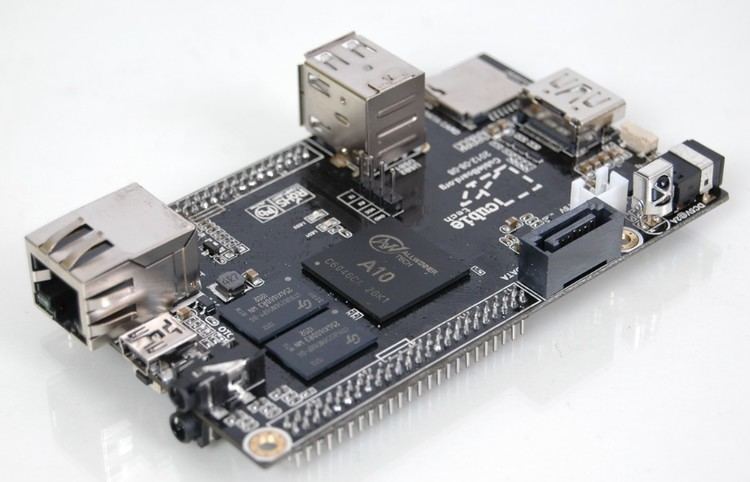Graphics Mali-400 MP | ||
 | ||
Release date October 2012; 4 years ago (2012-10) Operating system Storage 4 GB NAND flash built-in, 1x microSD slot, | ||
Cubieboard is a single-board computer, made in Zhuhai, Guangdong, China. The first short run of prototype boards were sold internationally in September 2012, and the production version started to be sold in October 2012. It can run Android 4 ICS, Ubuntu 12.04 desktop, Fedora 19 ARM Remix desktop, Arch Linux ARM, a Debian-based Cubian distribution, or OpenBSD.
Contents
It uses the AllWinner A10 SoC, popular on cheap tablets, phones and media PCs. This SoC is used by developers of the lima driver, an open-source driver for the ARM Mali GPU. It was able, at the 2013 FOSDEM demo, to run ioquake 3 at 47 fps in 1024×600.
The Cubieboard team managed to run an Apache Hadoop computer cluster using the Lubuntu Linux distribution.
Cubieboard1
The little motherboard utilizes the AllWinner A10 capabilities
Cubieboard2
The second version, sold since June 2013, enhances the board mainly by replacing the AllWinner A10 SoC with an AllWinner A20 which contains 2 ARM Cortex-A7 MPCore CPUs and a dual fragment shader Mali-400 GPU (Mali-400MP2).
This board is used by Fedora to test and develop the Allwinner SoC port of the distribution.
There is also a version available with two microSD card slots.
Cubietruck (Cubieboard3)
The third version has a new and larger PCB layout and features the following hardware:
There is no LVDS support any longer. The RTL8211E NIC allows transfer rates up to 630–638 Mbit/s (sending while 5–10% idle) and 850–860 Mbit/s (receiving while 0–2% idle) when simultaneous TCP connections are established (testing was done utilising iperf with three clients against Cubietruck running Lubuntu)
To connect a 3.5" HDD the necessary 12 V power can be delivered by a 3.5 inch HDD addon package which can be used to power the Cubietruck itself as well. Also new is the option to power the Cubietruck from LiPo batteries.
Cubieboard 4
On May 4, 2014 CubieTech announced the Cubieboard 4, the board is also known as CC-A80. It is based on an Allwinner A80 SoC (quad Cortex-A15, quad Cortex-A7 big.LITTLE), thereby replacing the Mali GPU with a PowerVR GPU. The board was officially released on 10 March 2015.
Cubietruck Plus (Cubieboard5)
The fifth version has the same PCB layout and almost the same features as the CubieTruck.
